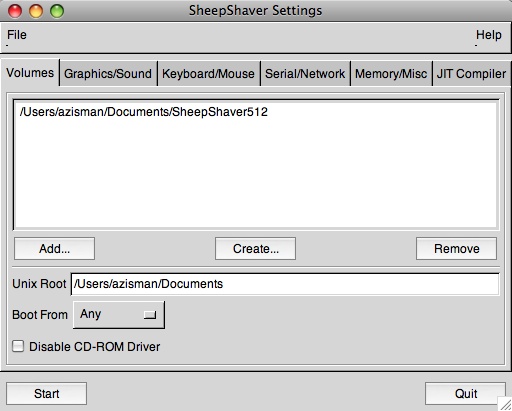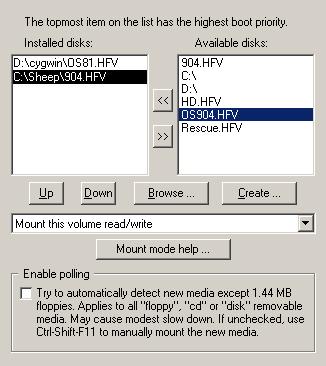

- Sheepshaver enlarge drive mac os x#
- Sheepshaver enlarge drive Offline#
- Sheepshaver enlarge drive windows 7#
Sheepshaver enlarge drive windows 7#
In OS X itchecks in "/Users//Library/Preferences/Gryphel/mnvm_rom/",and then also in "/Library/Application Support/Gryphel/mnvm_rom/".In Windows 7 and Vista, "C:\Users\\AppData\Roaming\Gryphel\mnvm_rom\".In Windows XP, "C:\Documents and Settings\\Application Data\Gryphel\mnvm_rom\".In Windows 98, "C:\WINDOWS\Application Data\Gryphel\mnvm_rom\".In the X Versions, "~/.gryphel/mnvm_rom".And in Macintosh Classic "System Folder:Preferences:Gryphel:mnvm_rom".The "mnvm_rom" folder may be an aliasto where ever you keep your ROM collection. If Mini vMac doesn't find theROM image in the locations described above, it willalso look in a specific central location. Or, if there is an argument ofthe form “-d ”, MinivMac looks for the ROM image in. In the X version, if the folder containing the application can not bedetermined, Mini vMac looks for the ROM image file in the current directory.For example, finding the application directory is not implementedin OpenBSD and Minix.Īlso in the X version, if an argument of the form“-r ” is used on the command line,that is used instead of the application directoryor current directory.
Sheepshaver enlarge drive mac os x#
Actually, the file is really named“” internally, but what you see is “vMac.ROM”.)And in the X versions you use a symlink, or "symbolic link".Īn exception to the above is that in the Mac OS X version,if you create a folder called “mnvm_dat”inside the “Contents” folder within the application bundle(control click on the application and choose “Show Package Contents”),then Mini vMac will look for the “vMac.ROM” file, and the disk1.dsk, disk2.dsk, etc files,within the “mnvm_dat” folder.This allows you to make a self contained Mac OS X application thatruns an application for the Mac Plus (especially when used with the“ AutoQuit”software.)

(It must be “vMac.ROM”,not “Shortcut to vMac.ROM”. The ROM image file may also be placed elsewhere, with an alias(named “vMac.ROM”) to it placed in Mini vMac’s folder."Alias" is the term used for Macintosh. Once you have told Mini vMacwhere the ROM image is, booting will resume.īefore giving up and asking you where the ROM image file is,the first location Mini vMac will look for it is in the foldercontaining the MinivMac application, with the name “vMac.ROM”. Or, in the Macintosh or Windowsversions, you can choose the “Open Disk Image.” commandfrom the “File” menu,or the ‘O’ command from the Control Mode to bringup the bring up the standard dialog. You can drag the icon of the file ontoto the Mini vMac window. If it does not find the ROM image, it will waitfor you to tell it where it is. When Mini vMac launches, it will look for a ROM image file in a numberof possible locations. If you don’t have a Macintosh Plus,you could check the“ Where to buy an old Macintosh”page. So to legally use Mini vMac, you need toown a real Macintosh Plus. Note thatthe ROM image file is copyright Apple Computer, and may notbe redistributed. A program such as“ CopyRoms”,when run on a real Macintosh Plus, will savethis information to a file, which can then be transferredto the computer on which you want to run Mini vMac. Enlist a good data management plan which includes ATTO RAID products to ensure your data is safe.The ROM (“Read Only Memory”) contains information needed forthe Macintosh Plus to function, and the emulation of theMacintosh Plus also needs this information. There are several methods available to access drives including forcing a rebuild to continue so data can be copied to a new RAID Group.
Sheepshaver enlarge drive Offline#
If all attempts at preventing a RAID Group from going offline have failed, Data Recovery Mode attempts to access data in an offline RAID Group. Period of time to keep data moving smoothly within a guaranteed latency response time.ĭownload DriveAssure Guaranteed Latency Tech Brief Situations when a drive in a RAID Group does not respond within a specified

Unwanted behavior such as dropped video frames. Perceived response time beyond what is desired for users. Through periodic drive scans,ĭriveAssure searches for bad sectors or slow spots in your disk drives and repairs them without failing theĭrive, preventing the loss of critical assets.Ī slow drive in a storage array can lead to delays which increase real or Proprietary algorithms and user controls to prevent premature drive failuresĪnd slow downs, ensuring uninterrupted access to data. DriveAssure™ provides bounded latency through


 0 kommentar(er)
0 kommentar(er)
